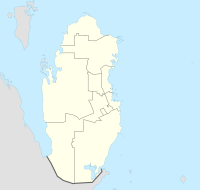Al Da'asa
| Location | Western Qatar |
|---|---|
| Coordinates | 25°22′10″N 50°48′32″E / 25.36944°N 50.80889°E |
| Type | Settlement |
| History | |
| Periods | Neolithic period |
| Cultures | Ubaid |
| Site notes | |
| Excavation dates | 1961 1978 |
| Archaeologists | Holger Kapel Beatrice De Cardi |
Al Da'asa is an archaeological site located on the western coast of Qatar. It is the most extensive Ubaid site in the country. It was excavated by a Danish team in 1961.
The site is theorized to have accommodated a small seasonal encampment, possibly a lodging for a hunting-fishing-gathering group who made recurrent visits. This is evidenced by the discovery of nearly sixty hearths at the site, which may have been utilized to cure fish, in addition to flint tools such as scrapers, cutters, blades and arrow heads. Furthermore, many painted Ubaid potsherds and a carnelian bead were found in the fire pits, suggesting overseas connections.
Under the leadership of Danish archaeologist Holger Kapel, several flint sites in Qatar were excavated from 1960 to 1964. Al Da'asa was the largest of these sites, and was discovered in 1961. A number of highly weathered potsherds were collected from the site for analysis. Shortly after, the site was revealed to a British excavation team who identified the potsherds as originating from the Ubaid period.
In addition to the 1961 excavation led by Holger Kapel, the site was again excavated in 1978 by a team led by Beatrice De Cardi.
Quern stone fragments, hearths and Ubaid pottery were discovered during the first excavation. A carnelian bead and three fragments of red, non-Ubaid pottery, thought to originate from the Arabian coast, were also among the discoveries.
Al Da'asa's residents are thought to have comprised fishermen or merchants from Ur. However, the stone tools uncovered are consistent with tools used elsewhere in Arabia during the Ubaid period and bear no resemblance to the tools used in southern Mesopotamia.
Postholes, meant for tents or huts, were noticed by the excavators. The mass number of hearths suggest mass activity took place during its occupational period, and may be attributed to a relatively sizable population in which each family cooked in a separate fire pit. Another possibility is that the hearths were made to cure and dry large amounts of fish.
...
Wikipedia

